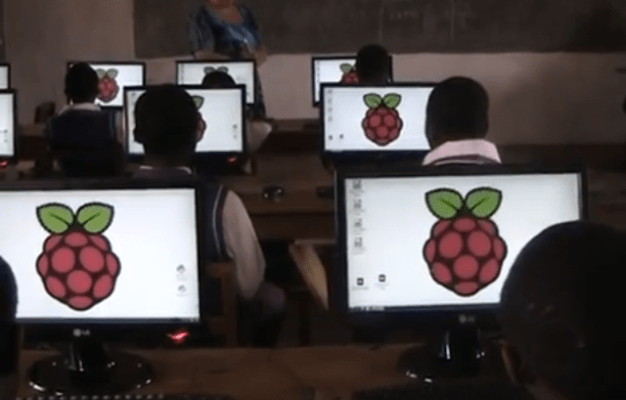The Raspberry Pi microcomputer has already put more than a million Pis in the hands of makers, tinkerers, parents and kids in its first year on sale. Which is an impressive feat for a device that’s designed to get more people dabbling in electronics and thinking about how software works. The Pi Foundation actually wanted to create a device that U.K. kids could cut their coding teeth on. But here’s a sign of how much more potential Pi has, above and beyond its original mission: Pis are being used to power a secondary school computing lab in rural Cameroon.
In a guest post on the Pi Foundation’s blog, a volunteer from a Belgian group that raised the funds to build and equip the school writes how they took 30 Pis out to Cameroon in their suitcase and used them to create a computing lab — along with screens, keyboards and mice bought locally. This Pi-powered computing class is itself powered by an on-site generator since the school is not connected to the public power network.
The school in question — Saint Marcellin Comprehensive College — is located in a small village called Binshua, close to Nkambe in the Northwest region of Cameroon. At present the Pis are being used for teaching the children how to use office productivity software but the aim is to get the kids coding too, in time:
All of the systems run on the Raspbian image from December, with LibreOffice and CUPS installed. The Pis are currently used to teach the children the basics of working with an Office suite. But we made sure that we gave the teacher a little introduction (and a good book) on programming in Scratch. So, now we are hoping that this will get Scratch introduced in the school curriculum as well.
The school’s lab doesn’t currently have an Internet connection but that’s something the Belgian group is working to change too.
The computers are all connected in a network. The central point of the network is a router that’s ready to be connected to a WAN modem. We hope to be able to provide a connection to the internet in the near future, which would certainly bring a small revolution into this rural area. Even without an internet connection, we believe that we created an advanced computer lab in this underdeveloped area. Giving the children in the area a chance to work their way to a better future. And that is our motivation.
It isn’t a stretch to say this small, low cost, low power microcomputer has the potential to provide a first computing experience for many more people in developing countries. The Pi hardware is cheaper than most mobile phones, let alone most smartphones — the other device touted as the likely first computing experience for the “next billions”. And it’s a lot cheaper than another Linux-based low cost computing project: the one laptop per child’s XO laptop (albeit, the price of the peripherals needs to be factored it).
In the following video, a teacher at the school is shown introducing the Pi to the class, and even though she mentions Microsoft’s Windows OS the reference is not likely to put smiles on many faces in Redmond: “This small box is not working with Windows operating system… It works with another type of operating system. It’s Linux. It’s also very popular — and it’s for free.”
